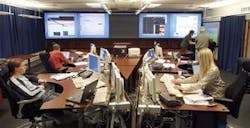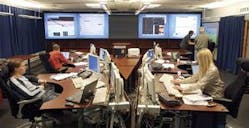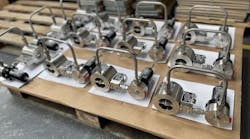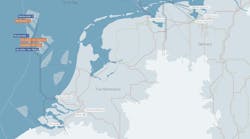Nick Terdre
Contributing Editor
Valhall is one of BP's five flagship fields of the future, its designation for the implementation of a suite of tech-nologies and working processes that allow better decisions to be taken faster, delivering increased value. Similar projects will be undertaken at four other sites around the world.
Valhall, a mature field, still has considerable potential. Although half of the recoverable oil reserves of some 1 Bbbl have been produced, the company believes the field could still be producing in 2050, providing license extension is granted and the frame conditions are supportive. A substantial increase in recoverables – 300-500 MMbbl – is in the pipeline, based on improving knowledge of the chalk reservoir. BP gained the Norwegian Petroleum Directorate's enhanced oil recovery prize last year for its work on Valhall.
The chalk reservoir requires a great deal of effort to maintain its productivity. The ability to do this has been enhanced by life-of-field seismic (LoFS) capability, commissioned last year. The reservoir knowledge in turn is a tool to be used in planning and implementing water injection on the field. The current program calls for 15 wells in a first phase. Most of them will be drilled from the new IP injection platform, which is equipped with state-of-the-art drilling equipment.
BP in Norway took its first steps toward the field of the future about three years ago, when it set up a pilot onshore operations center at its Stavanger headquarters to serve operations on both the Valhall and Ula fields. In late 2002, it established its first drilling onshore operations center, a state-of-the-art room where both BP and specialist contractors provide real-time support to the drilling operations on Valhall IP.
According to Paul Hocking, lead engineer, Field of the Future, the next step will be to introduce an integrated operating environment (IOE). This will take the form of separate operations centers for each field. The Ula center is currently under construction, while that for Valhall is going through the design and approval process.
The centers will each consist of an integrated operations room, typically with an onshore production supervisor and planning and maintenance support personnel, in contact with the production and maintenance supervisors offshore, and a production optimization room, typically with a production engineer and well engineer talking to the control room offshore. Valhall, which has a more complex and demanding reservoir, will also have a well maintenance and support room.
null
Fiber-optic platform
Underlying the development of such onshore support facilities is fiber-optic communications, Hocking says. Being able to move massive volumes of data for transfer at lightning speed to the beach allows operations and equipment to be monitored in real-time at a minute level of detail. This capability makes it possible both to fine-tune operations and to respond rapidly when something goes wrong or when there are signs that something might go wrong. The bottom line is that better decisions can be made faster.
Specialist expertise no longer has to be present on the platform, but can be provided from ashore. In the case of BP's drilling onshore operations center, it was possible to move a long list of specialist drilling and well functions to shore, including well-site geologists, directional drilling specialists, logging engineers, drilling data engineers, geo-mechanics, mud engineers and geologists. This development also improves safety by reducing the number of personnel working and traveling offshore.
An example of rapid response to an interruption of operations is the time a tool failed downhole. The control room hooked up directly to the well services contractor, Baker Hughes, which has its own support room for its BP operations. By direct communication via fiber-optic link to the platform, the contractor was able to reprogram the tool downhole. That saved $300,000 by not having to fly a specialist out to the platform and trip out to retrieve the tool, with all the downtime that would have entailed.
Finding ways to realize the potential of the technologies that can be brought to bear on offshore production operations is no easy task, in Hocking's view. First of all, it is important to come to grips with the organizational and human factors, he says. Stakeholder analyses have been carried out to identify who is involved in the different processes. Getting this right up-front makes sense. Even something as simple as getting a valve repaired is a complex operation involving numerous people. The next step is to work out how to bring in the technology.
Cord initiative
BP initially used the ISO standard for control room design but soon came up against its limitations. To help plot a path through this frontier territory, it works with other operators making the same journey – ConocoPhillips, Norsk Hydro, and Statoil, which all support a Norwegian R&D initiative known as Cord. By summer, the group plans to start developing a practical methodology for human factors design of functions to be incorporated into an integrated operations environment.
As the IOE is further developed, the onshore facilities will take on longer-term planning and optimization. BP is developing an optimizer model that incorporates not only sub-models for elements such as reservoir and facilities, but also a business model providing the market context for production.
Information management is a crucial activity. An information hub or master historian has been developed in which all historical data is gathered. External suppliers are able to access data relevant to their service via data-to-desktop (D2D) links.
The field of the future is not just a fascinating experiment but something that could substantially improve bottom-line performance. As Hocking says, "It's an evolutionary process. We are making gradual changes that over time will amount to step changes that add significant additional value to our operations."






